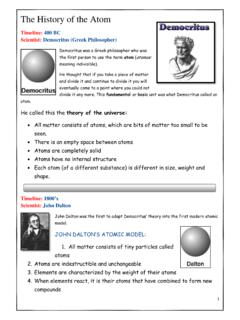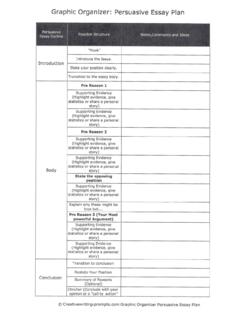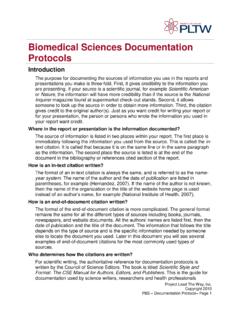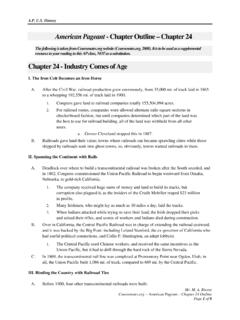Transcription of Introduction to Astronomy - Socorro Independent School ...
1 1 Introduction to Astronomy From Darkness to Blazing Glory Published by JAS Educational Publications Copyright Pending 2010 JAS Educational Publications All rights reserved. Including the right of reproduction in whole or in part in any form. Second Edition Author: Jeffrey Wright Scott Photographs and Diagrams: Credit NASA, Jet Propulsion Laboratory, USGS, NOAA, Aames Research Center JAS Educational Publications 2601 Oakdale Road, H2 Box 197 Modesto California 95355 1-888-586-6252 Website: http://. Printing by Minuteman Press, Berkley, California ISBN 978-0-9827200-0-4 2 Introduction to Astronomy From Darkness to Blazing Glory The moon Titan is in the forefront with the moon Tethys behind it. These are two of many of Saturn s moons Credit: Cassini Imaging Team, ISS, JPL, ESA, NASA 3 Introduction to Astronomy Contents in Brief Chapter 1: Astronomy Basics: Pages 1 6 Workbook Pages 1 - 2 Chapter 2: Time: Pages 7 - 10 Workbook Pages 3 - 4 Chapter 3: Solar System Overview: Pages 11 - 14 Workbook Pages 5 - 8 Chapter 4: Our Sun: Pages 15 - 20 Workbook Pages 9 - 16 Chapter 5: The Terrestrial Planets: Page 21 - 39 Workbook Pages 17 - 36 Mercury: Pages 22 - 23 Venus: Pages 24 - 25 Earth: Pages 25 - 34 Mars: Pages 34 - 39 Chapter 6: Outer, Dwarf and Exoplanets Pages: 41-54 Workbook Pages 37 - 48 Jupiter: Pages 41 - 42 Saturn: Pages 42 - 44 Uranus: Pages 44 - 45 Neptune.
2 Pages 45 - 46 Dwarf Planets, Plutoids and Exoplanets: Pages 47 -54 4 Chapter 7: The Moons: Pages: 55 - 66 Workbook Pages 49 - 56 Chapter 8: Rocks and Ice: Pages 67 - 75 Workbook Pages 57 - 64 Asteroids: 68 - 69 Comets: Pages 69 - 71 Meteors: Pages 72 - 75 Chapter 9: The Stars: Pages 76 - 87 Workbook Pages 65 - 82 Chapter 10: Galaxies: Pages 88 - 93 Workbook Pages 83 - 90 Chapter 11: The Universe: Pages 94 - 100 Workbook Pages 91 -94 Chapter 12: History of Rocketry: Pages 101 - 105 Workbook Pages 95 - 98 Chapter 13: Early Space Exploration: Pages 106 - 113 Workbook Pages 99 - 102 Chapter 14: Manned Exploration 1959 -1976 Russians in Space: Pages 114 - 118 5 Workbook Pages 103 - 106 Chapter 15: Manned Exploration Americans in Space 1959 1979: Pages 119 - 125 Workbook Pages 107 - 110 Chapter 16: History of Space Explorations 1973 2009: Pages 126 - 139 Workbook Pages 111 - 118 Chapter 17: SETI: Pages 140 - 150 Workbook Pages 119 - 126 Chapter 18: The Night Sky: Pages 151 - 155 Workbook Pages 127 - 130 Glossary: Pages 156 - 171 Index: Pages 171 -182 All homework assignments are located on the student DVD.
3 Additional support items are found on the website: Reports and projects are supplied by teacher. 6 This book is an Introduction to Astronomy . While providing education, the book is meant to spark passion for the science and the space industry by highlighting discoveries and outcomes. Do you want to be a part of this exciting field? Our nation needs your help to continue to reach new heights in space science and industry. Be sure to check the end of your CD for professional opportunities. As we begin our study, take a moment to ponder where we are in space and what we live on; a very special planet. A beautiful earthrise over our Moon Photo courtesy of NAS 7 A note to the reader: The Earthrise photo was taken by a man standing on the Moon, looking back at his home planet, Earth.
4 The ground upon which he was standing used to be a part of Earth. The Moon used to be so close to us that much of the horizon would have been half covered by a primordial moonrise. This desolate satellite is slowly drifting away, at a rate of a little over an inch a year. Something to If I am looking through a telescope at a man up on the Moon, and he is looking up through telescope at me on Earth at the same time, how can we both be looking up at each other? Please discuss this dilemma. A virtual vacuum of space surrounds our planet. It can be airless, dark, and cold. Or it can be radiation filled, bright and hot. You will learn why and what is in the Universe and how it works. Please explore the book and DVD much as scientists explore the Universe, with a questioning spirit and a curious mind.
5 While reading you might want to ask yourself a few questions: What, or who, created the Universe? Does it exist for a purpose, or is it a random place that is devoid of reason? What unanswered questions remain about the Universe? What is in this book and DVD that could apply to your life? The information in this book represents a sampling of what has been discovered about our planet, our star, our solar system, and beyond. If you find this field of study interesting there are videos, books, lectures, web sites, articles, conventions, workshops, magazines, and college courses available. Stay updated on the constant flow of information concerning new discoveries resulting from the exploration of space. Jeff Scott 1 R e q u ire d W o r k: H o m ew o r k D VD W o r k bo o k : Page s 1- 4 Astr o n o m y Basic s Test (Te ac h e r Pr o vide d ) Chapter 1 Astronomy Basics R e q u ire d W o r k: H o m ew o r k C d W o r k bo o k : Page s 1 - 4 Te st Pr o vide d by th e Te ac h e r Tour Guide 2 A photo from the Hubble Space Telescope Courtesy NASA What is Astronomy ?
6 When did it begin? Astronomy is a study of virtually everything beyond earth. The academic discipline includes studying planets, solar systems, stars, galaxies, comets, asteroids, nebulae, moons and the Universe itself. You will learn about these fields of study as you read this book. Astronomy has produced a relatively new field: astrobiology. So far, this scientific endeavor only speculates about possible alien life. But, as you will study in this book, there are possibilities of alien life even inside our solar system. Part of the astronomical science community is actively listening for new signs of life in the cosmos (Another word for universe.). This organization is called the SETI Institute. The abbreviation stands for: Search for Extra Terrestrial Intelligence. A very active part of Astronomy consists of teams of astronomers looking for exoplanets.
7 These exoplanets are circling stars outside our solar system. Literally hundreds of these planets have been found. Several new ones are discovered every month. Many new discoveries that have been made over the last 40 years have been heavily computer dependent. Modern Astronomy relies upon technology, math and scientific method. Sk il ls an d To o l s o f th e tr ad e Astronomy is a visually - based science. The skill of careful observation is essential to understanding and discovery. Many astronomical skills were developed as long as 5,000 years ago. Before written history began, people had noticed the interrelationships between the Sun, Moon and the Earth. Observations resulted in a rudimentary understanding of the timing of days, nights, monthly patterns of moonlit shapes and the seasons.
8 Missing were scientific reasons for these events. When there were no answers for natural occurrences, observers concluded that it was caused by actions of the gods. Astrology and its astrologers were cosmos based, religious fortune tellers and the gods will , messengers. They closely studied the stars, planets, the moon and sun and then tried to derive meaning for their movements. At times important decisions (war, marriages, coronations, etc.), were timed because of predictions put forth by these astrologers. Some of their observations were quite helpful. They could advise when to plant and harvest. They could determine when the next full moon night would occur. For those who lived near coasts, they could predict tides. They learned to use star patterns for day and night time navigation.
9 The skills of writing and mapping drastically improved this combined religion and science of astrology and Astronomy . By 3 mapping and writing down observations, others were able to reutilize the saved information. Soon they were able to not only observe, but also record and predict astronomical events over long periods of time. The study of Astronomy /astrology became an important development in the history of civilization. Skills of predicting weather patterns and seasons allowed man to time harvests. From this, each man no longer had to just hunt, gather and maintain flocks. Agriculture was developed, creating greater food supplies this led to larger populations, spare time to build, invent and develop communities. Star observation and mapping allowed for the navigation of new land and sea routes.
10 Trade and exchanges of ideas developed between cultures. Over time, ancient civilizations gained wealth, power and improved technology based on the increased amounts of food and trade, that was inspired by studying the cosmos. Mathematics was integral to the advancement of astronomical studies. The ancient people of Egypt and Greece developed algebra and geometry. Through these math skills and little else, a Greek citizen named Aristarchus, in 270 BC first figured out how far the moon was from the earth. This brings us to another important component: philosophy. Greek philosophers developed this rational process of thought. This skill is the foundation of Astronomy . We now call this process: the scientific method: 1) Propose a question. 2) Observe and research. 3) Construct a hypothesis.









